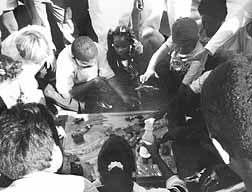![]()
![]()
![]()
![]()
![]()
![]()
![]()
"A watershed is a marvelous thing to consider: this process of rain falling, streams flowing, and oceans evaporating causes every molecule of water on earth to make the complete trip once every two million years."
-- Gary Snyder
by Alice Martinez
![]() he February meeting of the Regional Water Quality Control
Board was a study in contrasts. After the revealing discussion concerning
expired and unprocessed pollution discharge permits, board members saw another
perspective on water quality and pollution into San Diego Bay. The next
item was a report on the "Student to student watershed education program"
being conducted with an EPA grant to the Environmental Health Coalition
(EHC).
he February meeting of the Regional Water Quality Control
Board was a study in contrasts. After the revealing discussion concerning
expired and unprocessed pollution discharge permits, board members saw another
perspective on water quality and pollution into San Diego Bay. The next
item was a report on the "Student to student watershed education program"
being conducted with an EPA grant to the Environmental Health Coalition
(EHC).
Educational efforts were based in the 460 square
mile Chollas Creek watershed which flows into San Diego Bay at the 32nd
Naval Street Station. Chollas Creek drains an area of 25 square miles where
the land use is 63 percent residential, 2 percent industrial, 15 percent
commercial and 20 percent open space (most of which is a cemetery). The
creek flows intermittently, mostly in a concrete channel.
The program was coordinated by Libby Lucas
of EHC and Keith Fink, a secondary life science instructor and biology professor
at University of San Diego. Working with students from the Lincoln/Gompers
schools in southeastern San Diego, ten high school students worked with
1,600 elementary school students in an environment designed to foster an
attitude of stewardship through peer tutoring. The six-week summer course
included speakers, field trips, and tours.

While Regional Board staff seems to be having
a problem with standards, local students forged ahead with their science
teachers. At many of the sites with expired or unprocessed pollution discharge
permits, water quality tests were performed by students. Students tested
for a number of indicators of water ecosystem health: total dissolved solids,
dissolved oxygen, phosphates, nitrates, copper and e. coli bacteria (an
indicator of fecal contamination). Tests were performed at five different
sites including the mouth of Chollas Creek as it goes into San Diego Bay
and at Southwest Marine Shipyard.
Copper and phosphate levels at every site were
above levels suggested to maintain a healthy estuarine ecosystem. There
were no reported problems with nitrates. E. coli was present at every site,
although they did not measure the levels. Commenting later, Board Executive
Director Dave Robertus stated, "a lot of the time it's the sea gulls."
But in San Diego, a lot of the time it's not.
Program graduate and student tutor Elizabeth
Quinonas is now inspired to continue environmental science teaching. "I
now know what a watershed is and about polluted runoff and what the alternatives
are. I learned that the only water that is treated is that from our homes.
I want to teach what is going on in our own backyards."
Libby Lucas of the Environmental Health Coalition
summed up their ongoing efforts:
"Educating the public leading to behavioral
changes takes time and popularizing of the issue. The stated goal of the
1972 Clean Water Act was 'to eliminate the discharge of pollutants to navigable
waters by 1985.' We have not achieved this, primarily because of site-polluted
runoff. Though we cannot see many of the pollutants in the runoff from upstream,
they are there - hydrocarbons, pesticides, dissolved metals and they
can pose a threat to people, fish and wildlife. What do we do about polluted
runoff? Education with a foundation of pollution prevention. Teach toxics
use reductions and elimination of pollutants as contrasted with pollution
control or treatment. One example of this is the storm drain stencils 'No
dumping, I live downstream.'
"Recycling wasn't always a household word
and now we believe it's time for polluted runoff to get to that point. Cleaning
up the pollution going into our watershed, creeks, estuaries and bays requires
the ongoing vigilance of the public combined with legislation requiring
the testing, monitoring and reporting of pollutants."
Watershed educational materials and success
stories may be found via Global Rivers Environmental Education Network,
206 South Fifth Avenue, Suite 150, Ann Arbor, Michigan 48104. Phone (313)
761-8142. Internet: www.econet.apc.org/green/
![]()
Outdoor Science Laboratory Open House
Lincoln/Gompers Cluster Schools
March 16, April 27 or May 4
Noon-3pm
Call 235-0281 for directions. The Gompers Schools lab area is just south of Highway 94 and west of Euclid Avenue.
![]() ake a tour of this wonderful 3.6 acre oasis in transition
to its natural habitat. The site contains a small creek bed which channels
runoff from a residential area north of the Martin Luther King Jr. freeway
and a portion of the freeway itself. Plans for site development include
an oak woodland plant community, a coastal sage restoration area, a freshwater
marsh habitat, water purification lab, butterfly garden, wind-powered generator
and alternative technology center.
ake a tour of this wonderful 3.6 acre oasis in transition
to its natural habitat. The site contains a small creek bed which channels
runoff from a residential area north of the Martin Luther King Jr. freeway
and a portion of the freeway itself. Plans for site development include
an oak woodland plant community, a coastal sage restoration area, a freshwater
marsh habitat, water purification lab, butterfly garden, wind-powered generator
and alternative technology center.
The Outdoor Environmental Science Learning
Laboratory is working to provide a shared resource for the schools to give
students hands-on experience and provide an environment to inspire enthusiastic
learning and a sense of stewardship for the environment.